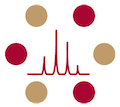Sample Preparation & Autosampler Vials for ESI-MS
Guidelines for sample preparation:
- Use appropriate solvents for the ESI-MS system.
a. Appropriate solvents include:
• Acetonitrile
• Methanol
• Water
b. If your compound is not sufficiently soluble in one of the above, you can first dissolve it in DMSO, but you must dilute the DMSO to 0.1%
or less in the sample you run. Samples for loop injection can be dissolved first in acetone or chloroform then diluted at least 1:20 in
acetonitrile.
c. Appropriate modifiers include volatile organic acids and buffers at 1% concentration or less
• Acetic acid
• Formic acid
• TFA (trifluoroacetic acid)
• Ammonium acetate
d. If your sample solution contains a high percent organic, use caution when running LC-MS methods. A large volume (>5uL) of injected
sample containing mostly organic solvent may result in:
• Column breakthough, where the sample elutes undetected in the solvent front. Lower injection volumes may allow sufficient mixing
of the sample with the mobile phase, but take care to avoid
• Sample or buffer precipitation, where when any sample component is not soluble in the initial mobile phase composition.
e. Never use mineral acids like HCl or sulfuric acid which can damage stainless steel instrument components.
f. Avoid detergents which can suppress ionization of your sample
g. Avoid non-volatile buffers like sodium phosphate which can suppress ionization and clog the electrospray source.
2. Ensure your samples are completely in solution, and that they will not precipitate out under the analysis conditions. Note that the
autosampler chamber is chilled, approx. 5°C.
3. Use appropriate concentrations for the LC-MS system
If none of the options listed above will work for your sample, please talk with Allis or Theresa. Inappropriate solvents or modifiers can damage the physical components of the LC-MS system, resulting is system downtime and expensive repairs.
| Purpose | Description | Unit | Manufacturer | Manufacturer P/N | VWR P/N |
|---|---|---|---|---|---|
| General use – vials & caps | Glass 2 mL clear vials with write-on spot, PTFE/silicone septa, blue caps | Pk 100 | Agilent | 5182-0865 | |
| Limited sample volume (<300 uL) vials | Polypropylene limited volume vials, narrow opening | Pk 100 | National Scientific | C4013-11 | 66030-982 |
| Limited sample volume (<300 uL) – caps | Caps for narrow opening vials (8-425) | Pk 100 | National Scientific | C4013-60A | 66030-420 |
Critical alerts regarding autosampler vials:
*Do NOT use limited volume vial inserts in the ESI-MS instrument! These will physically damage the autosampler, resulting in a service call and days of instrument downtime.
*Do NOT reuse autosampler vials! Used septa are prone to coring and bits of the septa get lodged in the flow path, blocking the flow and rendering the instrument unusable. The cents per vial that are saved are not worth the damage to the instrument and the aggravation caused to all who use and maintain the instrument. (Not to mention the contamination risk to your experiments and data integrity!)
Because these issues are entirely preventable and traceable, repair costs for repeat incidents, approximately $400, will be charged to the user responsible.
